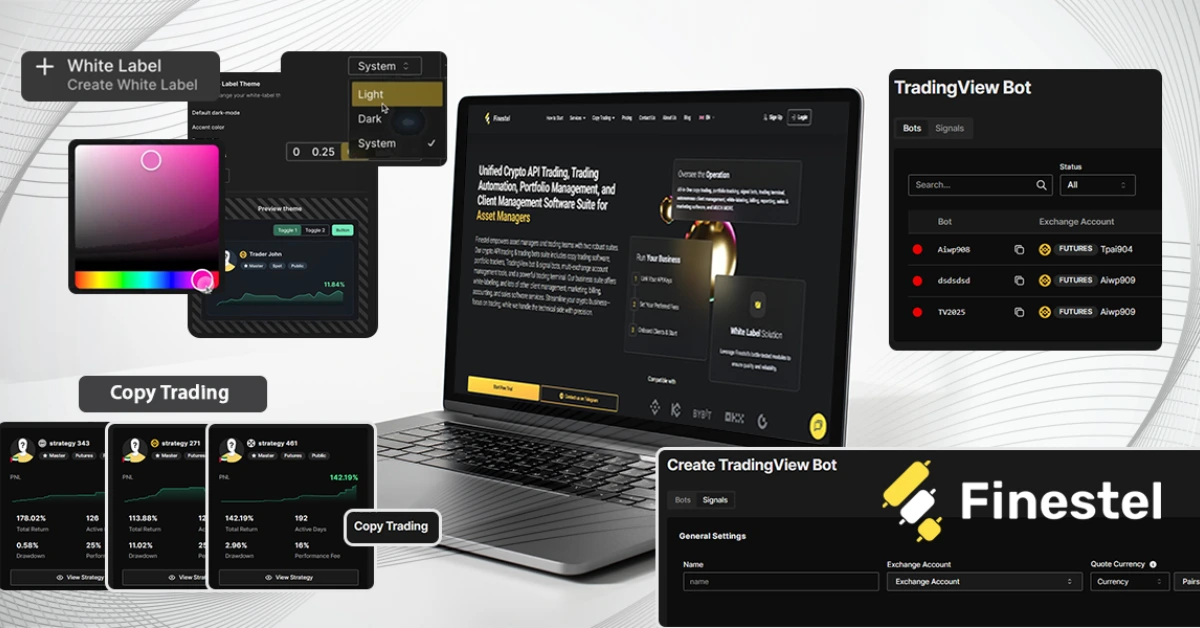
The rise of copy trading platforms and trade copiers has given asset managers and professional traders new ways to scale their strategies across dozens (or even hundreds) of client accounts. But while many solutions promise automation, the real test comes down to performance: how fast trades replicate, how reliable the system is under stress, and whether it holds up when scaled beyond a handful of accounts.
This article benchmarks Finestel, a pioneer in all-in-one SaaS platforms for asset managers. Instead of a feature rundown alone, we put the system through a lab-style test, measuring latency, replication drift, order fill variance, and dashboard responsiveness. The results show how well the software holds up when pushed under real-world conditions.
Before diving into benchmarks, it’s worth explaining what Finestel is and why we chose it for this review. Unlike single-purpose bots or lightweight retail copy-trading apps, Finestel was one of the first platforms designed as an all-in-one SaaS system for more professional traders and asset managers in crypto & forex, who try to manage multiple accounts and clients. As they mentioned,
The platform combines:
Because it positions itself as a professional-grade trade copier and client management stack, Finestel is a natural candidate for benchmarking. The promise of being able to scale from ten accounts to hundreds is compelling, but it’s only credible if the performance data backs it up.
For professional traders and asset managers, latency and reliability are not optional. A delay of even one second in a volatile crypto market can mean slippage that erodes client trust. Similarly, a copier that fails under throttling conditions can lead to inconsistent performance across accounts.
Benchmarking trade copiers offers two benefits:
We structured the benchmark like a controlled experiment, designed for reproducibility.
Pass/Fail Criteria (Based on the Test Data):
Copy Latency
Order Fill Variance
Replication Drift
Dashboard Responsiveness
Uptime Snapshot
Overall: All benchmarks passed within professional thresholds.
The test results suggest a few key takeaways:
Benchmarks only make sense when viewed against the broader landscape. Many copy-trading solutions work well with a handful of accounts but begin to degrade once scaled beyond 50. Common issues include:
By contrast, the benchmarked results show that Finestel maintained low latency, minimal drift, and responsive dashboards even at 200 accounts under stress. This doesn’t mean it’s flawless, but it suggests the platform’s architecture was built with scale in mind—something lightweight, retail-focused copiers typically don’t address.
From a purely technical perspective, Finestel clears the benchmark across latency, drift, order variance, and uptime. But benchmarks are not static—they matter most as the industry evolves. With forex integrations (MT4/MT5) underway, the same questions of replication speed and stability will soon apply across both crypto and traditional markets.
For asset managers, this kind of testing isn’t just about validating a single product—it’s about de-risking growth decisions. Moving from 20 to 200 clients requires confidence that the underlying infrastructure won’t buckle under stress.
Our verdict is simple: Finestel passes today’s benchmarks, and it sets a high bar for what trade copiers need to deliver as portfolios and markets diversify.
CoinPedia has been delivering accurate and timely cryptocurrency and blockchain updates since 2017. All content is created by our expert panel of analysts and journalists, following strict Editorial Guidelines based on E-E-A-T (Experience, Expertise, Authoritativeness, Trustworthiness). Every article is fact-checked against reputable sources to ensure accuracy, transparency, and reliability. Our review policy guarantees unbiased evaluations when recommending exchanges, platforms, or tools. We strive to provide timely updates about everything crypto & blockchain, right from startups to industry majors.
All opinions and insights shared represent the author's own views on current market conditions. Please do your own research before making investment decisions. Neither the writer nor the publication assumes responsibility for your financial choices.
Sponsored content and affiliate links may appear on our site. Advertisements are marked clearly, and our editorial content remains entirely independent from our ad partners.
Bitcoin may look calm after weeks of choppy trading, but a much bigger story is…
The U.S. economy stands at a critical juncture as investors await the Federal Reserve’s December…
XRP got a big boost after Bitwise Asset Management added it to its Bitwise 10…
Brevis, a ZK verifiable computing platform, has teamed up with multi-chain DEX Aster to tackle…
BestChange is a global crypto exchanger aggregator, giving users access to a broad world of…
Solana price is showing early signs of stabilization after weeks of persistent downside pressure, as…